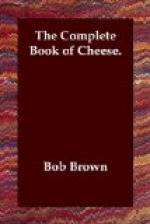Neufchatel Style
2-1/2 cups grated imported Swiss 1-1/2 tablespoons
flour 1 clove of garlic 1 cup dry white wine Crusty
French “flute” or hard rolls cut into big
mouthfuls, handy
for dunking
1 jigger kirsch Salt Pepper Nutmeg
The cheese should be shredded or grated coarsely and mixed well with the flour. Use a chafing dish for cooking and a small heated casserole for serving. Hub the bottom and sides of the blazer well with garlic, pour in the wine and heat to bubbling, just under boiling. Add cheese slowly, half a cup at a time, and stir steadily in one direction only, as in making Welsh Rabbit. Use a silver fork. Season with very little salt, always depending on how salty the cheese is, but use plenty of black pepper, freshly ground, and a touch of nutmeg. Then pour in the kirsch, stir steadily and invite guests to dunk their forked bread in the dish or in a smaller preheated casserole over a low electric or alcohol burner on the dining table. The trick is to keep the bubbling melted cheese in rhythmic motion with the fork, both up and down and around and around.
The dunkers stab the hunks of crusty French bread through the soft part to secure a firm hold in the crust, for if your bread comes off in dunking you pay a forfeit, often a bottle of wine.
The dunking is done as rhythmically as the stirring, guests taking regular turns at twirling the fork to keep the cheese swirling. When this “chafing dish cheese custard,” as it has been called in England, is ready for eating, each in turn thrusts in his fork, sops up a mouthful with the bread for a sponge and gives the Fondue a final stir, to keep it always moving in the same direction. All the while the heat beneath the dish keeps it gently bubbling.
Such a Neufchatel party was a favorite of King Edward VII, especially when he was stepping out as the Prince of Wales. He was as fond of Fondue as most of the great gourmets of his day and preferred it to Welsh Rabbit, perhaps because of the wine and kirsch that went into it.
At such a party a little heated wine is added if the Fondue gets too thick. When finally it has cooked down to a crust in the bottom of the dish, this is forked out by the host and divided among the guests as a very special dividend.
Any dry white wine will serve in a pinch, and the Switzerland Cheese Association, in broadcasting this classical recipe, points out that any dry rum, slivovitz, or brandy, including applejack, will be a valid substitute for the kirsch. To us, applejack seems specially suited, when we stop to consider our native taste that has married apple pie to cheese since pioneer times.
In culinary usage fondue means “melting to an edible consistency” and this, of course, doesn’t refer to cheese alone, although we use it chiefly for that.




